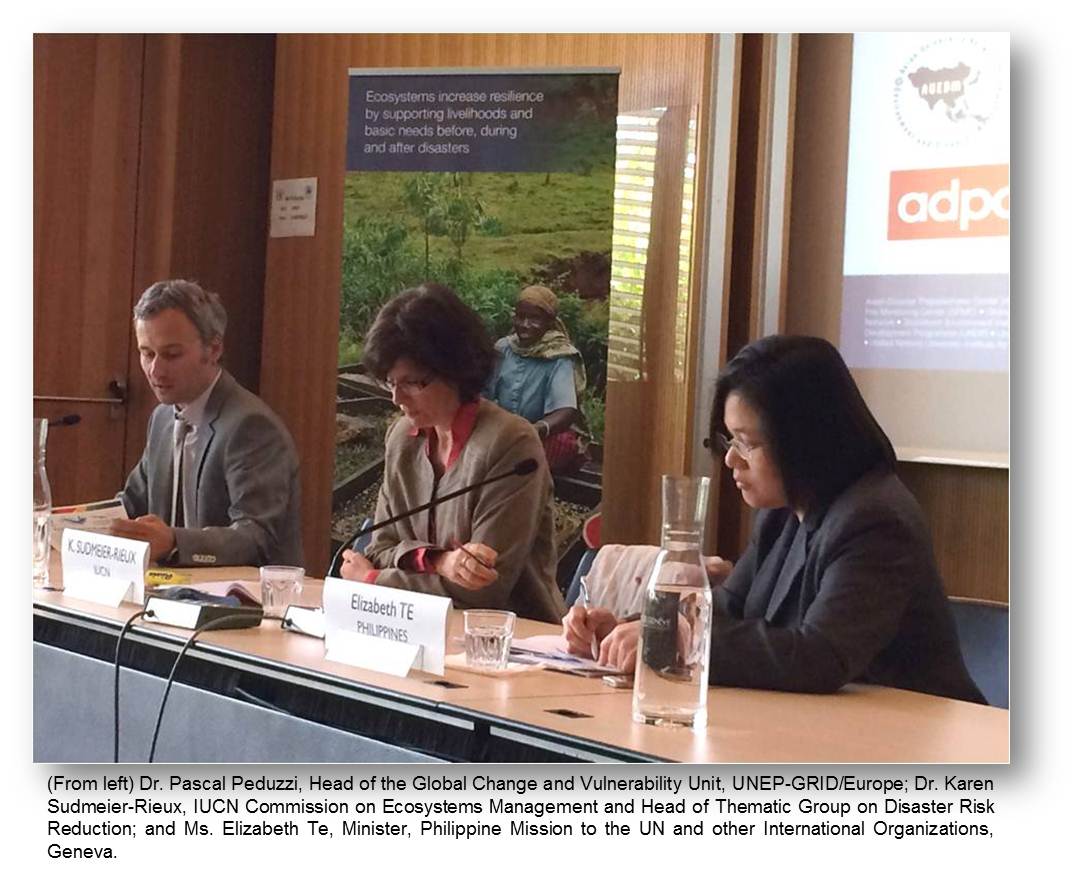
10 June 2014 – Ms. Elizabeth Te, Minister of the Philippine Mission to the United Nations (UN) and other International Organizations in Geneva, reiterated the call of the Philippines to support the country’s draft resolution on “Wetlands and Disaster Risk Reduction.”
“It is our hope that the resolution would become an instrument that would enable Parties to take actions in developing a set of guidelines which emphasize disaster risk reduction through the wise use of wetlands.” This was stressed by Ms. Te at the Partnership for Environment and Disaster Risk Reduction (PEDRR) Seminar on the theme, "From Natural Disasters to Natural Defenses - Seeing Nature as Part of the Solution," which was held on June 5, on the occasion of World Environment Day, at the International Environment House in Geneva, Switzerland.
Ms. Te presented the draft resolution on behalf of the Biodiversity Management Bureau of the Department of Environment and Natural Resources at the 47th Meeting of the Standing Committee of the Ramsar Convention on Wetlands, which was convened on 24 – 28 March 2014 in Gland, Switzerland. Proposed draft resolutions are expected to be finalized by November 2014, before their adoption at the 12th Conference of the Parties of the Ramsar Convention, which will be held from June 1 to 9 in Punta del Este, Uruguay.
At the PEDRR seminar, Ms. Te further emphasized that the Philippines views nature as a part of the solution in developing disaster-resilient communities. She noted that the country recognizes the important role of mangrove forests as natural barriers that protect coastal communities from typhoons, strong waves, storm surges, soil erosion and siltation. As such, the country is re-aligning some targets of the National Greening Program for mangrove establishment and rehabilitation. To reduce the dependence of coastal communities on the country’s marine resources, the government is also providing alternative sources of livelihood for the coastal communities, including in mangrove rehabilitation activities.
Ms. Te also reported that the Philippines will soon be implementing Guidelines on Mangrove and Beach Forests Development in Disaster-Risk Areas in the Philippines, which the DENR drafted in May. The guidelines provide instructions for site assessment and selection; matching suitable species within each zone; nursery establishment for beach forest and mangrove species; planting strategies and maintenance, monitoring and evaluation, and a sustainability mechanism.
Ms. Te further noted the filing of Senate Bill No. 2179 introduced by Senator Paolo Benigno Aquino IV on the establishment of a National Coastal Greenbelt Program. The objective of the bill is to establish coastal greenbelts—100-meter protection zones, initially for the Eastern Pacific seaboard of mangroves and beach forests—to mitigate the impact of waves and storm surges brought by typhoons and tsunamis.
Dr. Pascal Peduzzi, Head of the Global Change and Vulnerability Unit, UNEP-GRID/Europe and lead author of the report on Managing the Risks of Extreme Events and Disasters to Advance Climate Change Adaptation of the Intergovernmental Panel on Climate Change (IPCC), also spoke at the PEDRR seminar. He presented the IPCC schematic and description of disaster risk, and noted that risk is dynamic and changing, varying with the hazard, exposure and vulnerability faced by the community.
Dr. Karen Sudmeier-Rieux, International Union for the Conservation of Nature (IUCN) Commission on Ecosystems Management and Head of Thematic Group on Disaster Risk Reduction, commended the Philippines for taking the ecosystems approach as preventive measures to reduce disaster risk in the country, adding that the Philippines is a good example worth emulating.
The PEDRR is a global alliance of UN agencies, non-governmental organizations and specialist institutes that aim to influence policy, enhance implementation and coordinate efforts in environmental management for disaster risk reduction, climate change adaptation and sustainable livelihoods. It promotes ecosystems management as the key strategy to reduce disaster risk, increase local resilience and adapt to a changing climate. END

